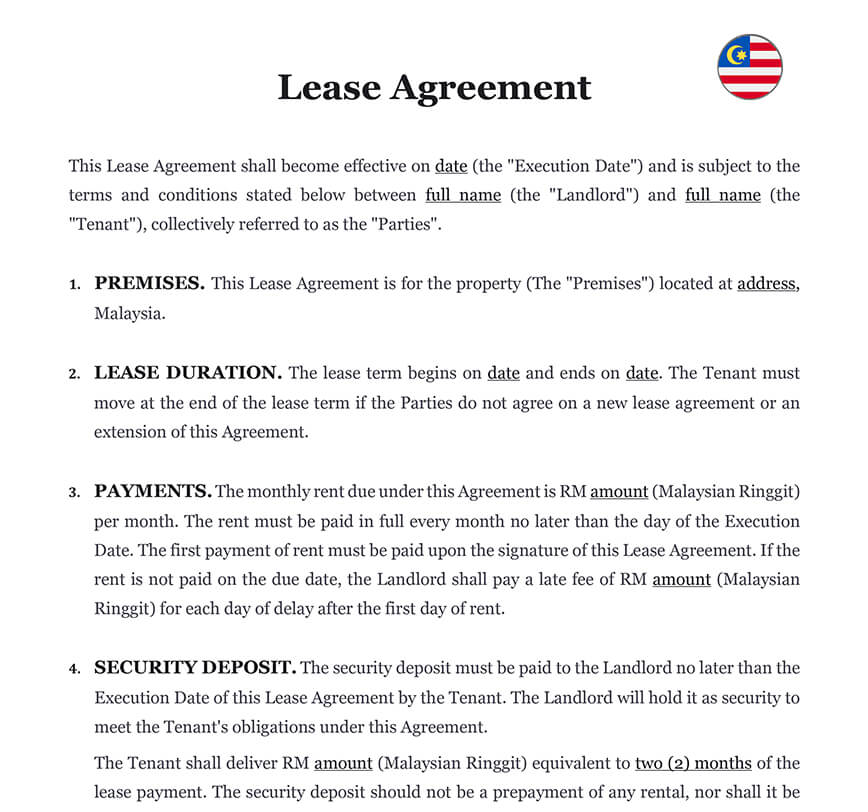Ready to use legal template
Drafted by experienced lawyers
Compliant with Malaysian law
Ready to use legal template
Drafted by lawyers
Compliant with Malaysian law
Home › Rent your property › Lease agreement
Learn more about Lease Agreement in Malaysia
A Lease Agreement is a legally binding contract between a landlord and a tenant that outlines the terms and conditions for renting a property. It specifies important details such as rental amount, payment terms, duration, security deposit, maintenance responsibilities, and termination conditions. In Malaysia, lease agreements must comply with relevant property laws, including the National Land Code 1965 and tenancy regulations, ensuring clarity and protection for both parties. Having a well-structured lease agreement helps prevent disputes, protects the rights of both landlord and tenant, and ensures compliance with local legal requirements. Download our professionally drafted Lease Agreement, fully editable in Word format, tailored for leasing properties in Malaysia.
Table of contents
What is a Lease Agreement?
A Residential Lease Agreement is a legally binding agreement between a landlord and a renter. It specifies both parties’ duties for the term of the lease. A landlord might use a lawyer to create the lease agreement to ensure that it is as comprehensive as feasible. In addition, the renter can hire their own lawyer to analyze the lease and make any necessary revisions before signing.
However, paying a lawyer to establish a lease agreement can be costly. As a result, many people prefer to construct their own agreement and ask the other side to sign it. There are no government laws governing what may and cannot be included. If neither party is diligent, the other can insert a slew of unfair provisions in their favor. Until the Residential Rent Act takes effect, the tenancy agreement is the sole instrument that protects the landlord’s and renters’ rights.
What types of properties are covered by the Lease Agreement?
A Lease Agreement can be used for a variety of residential properties, including:
| ➤ Apartment |
| ➤ Condo |
| ➤ Duplex |
| ➤ House |
| ➤ Office |
| ➤ Townhouse |
What is included in the Lease Agreement?
Lease agreements in Malaysia are prepared by the landlord’s lawyer. The tenancy agreement must be stamped in order to be utilized as evidence in court. Tenancy agreements are typically written for one to three years; tenancy renewal and rent modifications should be agreed with in advance. There is no standard format for these agreements, although they typically include the following provisions:
1. Property Specifics
Describe the type of house being rented and its location. Specify the unit number in non-landed properties. Also, specify if you’re renting out the entire flat or just a portion of it.
It’s also a good idea to mention the property’s condition. The landlord must submit an inventory in the contract, and the tenant must affirm and reconfirm the existence and condition of these objects before signing.
2. Deposits and Rental Amounts
Indicate the precise monthly rent that the tenant must pay, as well as the payment’s due date and method of payment such as cash, bank deposit, or wire transfer. Include the amounts for the Earnest Deposit, Security Deposit, and Utility Deposit as well.
3. Renewal Option and Tenancy Period
The tenancy period is a set amount of time during which the tenant rents the property. When drafting the agreement, you must be precise about the length and duration. Specify the date the agreement was signed, as well as the start and end dates of the renting period.
Any rental of longer than three years is considered a lease, not a tenancy. If you rent on a monthly basis, make sure to record it as well.
- Remarks:
In addition, you can also include terms that provide the renter the option to renew or extend the tenancy for a set amount of time, subject to specific conditions.
What to do before signing a Lease Agreement?
Step 1. Examine the property
Before signing a lease, you should always inspect the property. Make a list of the primary qualities or needs you’re searching for in a house to evaluate if it’s practical and a good fit for you. Get a broad sense of the complex, street, or neighborhood to determine if you’d like to live there, noting amenities like stores, neighbors, and safety.
Step 2. Inquire if any damage will be repaired
If you see any damage during the inspection, ask the agent or landlord if it will be repaired before you move in. If they agree, get it in writing to avoid any misunderstandings later on.
🔗 To help you draw up a home inspection checklist before your tenant moves in or when they move out, you can download our Property Rental Inspection Report template to make sure you don’t forget anything and that you are professional. It will also give your tenant a good impression.
A tenancy agreement will usually specify who is responsible for property maintenance and who is liable for damages. Most landlords require that a property be returned to its original state when vacated; it is best to agree on what, if anything, needs to be done with the landlord a few months before vacating the property. This increases the likelihood of a tenant receiving their entire deposit back.
Step 3. Read the lease properly
While it may appear tedious and complicated, read the full lease agreement to ensure you understand exactly what you’re signing up for. Keep a look out for any lease clauses that are too tight or unfair for your tenancy or lifestyle. You should also pay close attention to any lease termination costs and terms. Better still, ask if you may take the lease home for a day so you can read it thoroughly and without being rushed into anything.
Also, double-check the lease length, rental price, how frequently and how rent must be paid to confirm it matches what was advertised and what the agent told you directly.
Step 4. Inquire whether your pet is welcome
Check whether the property is pet friendly. If pets are permitted, make certain you understand what this entails. They may still be restricted from coming inside or making any noise. It may also be limited to a certain sort of pet, such as a little outdoor dog.
You should also consider the property’s compatibility for your pet, such as if it is properly and securely fenced.
Step 5. Check to see if you'll be able to sublet
If you want to sublease a room to make some extra money, be careful to check with the agent beforehand, as leases typically include a provision against subletting. If the landlord allows the tenant to sublet the property, make sure that you sign the letter of Consent to Sublet and have a specific period of time to do so. You must check on this first, whether you want to locate someone to share with and eventually put on the lease yourself, or rent a place through a room-sharing service like Airbnb. This may not only be against the landlord’s wishes, but it may also be against strata by-laws if you live in a complex.
How to legally terminate a Lease in Malaysia?
Some landlords prefer tenancy agreements that include an exit provision that allows for early termination of the tenancy; this is also known as a diplomatic clause. The provision frequently requires the landlord to be reimbursed for at least two months’ rent or to be given two months’ Eviction Notice. A tenant who wishes to terminate a contract early must frequently provide proof of departure, such as the cancellation of a work permit. Most tenancy agreements do not include an exit clause that takes effect during the first 12 months of the lease.
Many landlords also require tenants to sign an inventory that identifies and describes the condition of all items in the property. It is recommended that you double-check its accuracy.
What are the Landlord responsibilities?
These include paying annual property taxes to the appropriate authorities, insuring the property, paying insurance premiums, and ensuring that the furniture and appliances provided are in excellent working order. Aside from the annual property tax, you should be aware of another type of tax if you are a landlord. This is rental income tax, which means that you, as the landlord, are taxed on the money you generate from renting out your homes.
You must pay Real Property Gains Tax (RPGT) when you earn from the sale of a property, and you must pay rental income tax when you profit from renting out a property.
What are the Tenant responsibilities?
These include paying rent and utilities on schedule, maintaining furnishings, appliances, and interiors, reporting the landlord of problems and structural defects, and adhering to condominium and landlord rules. Because the unit can only be used for residential purposes, the occupant cannot operate a commercial business from it.
Explicitly prohibit the use of vices and illegal activities such as gambling and drugs, as well as anything that could jeopardize the property’s insurance coverage. Any renovations to the property are prohibited. The landlord may also impose restrictions, such as limiting the home’s use to one family or a set number of people.
SPECIAL OFFER
Landlord
10 Document Package
Essential documents for managing rental property in Malaysia
Share information
Why Themis Partner ?
Make documents forhundreds of purposes
Hundreds of documents
Instant access to our entire library of documents for Malaysia.
24/7 legal support
Free legal advice from our network of qualified lawyers.
Easily customized
Editable Word documents, unlimited revisions and copies.
Legal and Reliable
Documents written by lawyers that you can use with confidence.




